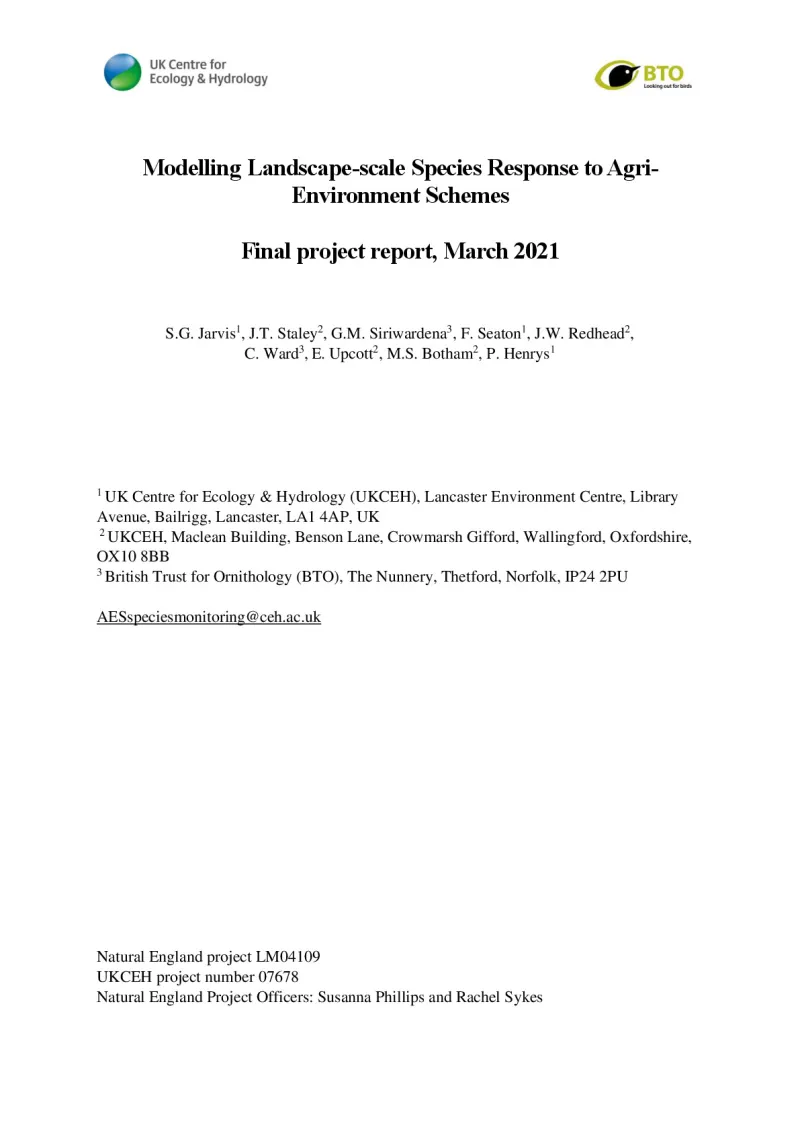Modelling Landscape-scale species response to Agri-Environment Schemes
The report focuses on whether the provisional taxon responses to the Agri-Environment Schemes (AES) gradients found in the Landscape-scale species monitoring of AES (LandSpAES) could be detected at a national scale.
- Other
- 2014-2022
- Environmental impacts


The aim of this project was to determine whether the provisional taxon responses to the AES gradients found in the LandSpAES project could be detected at a national scale using citizen science (CitSci) scheme data.
To achieve this aim, three key questions were addressed through the analytical work:
- Can the addition of covariates account for environmental variation between survey squares in each dataset to improve the comparability of AES gradient effects between LandSpAES and CitSci schemes?
- Do the CitSci scheme datasets show similar relationships between taxa responses and the AES gradients to those found with the LandSpAES data?
- Can integrated approaches to combining datasets be used to jointly model CitSci and LandSpAES data, and does integrated modelling reduce uncertainty in quantifying the effects of AES gradients on taxa responses at a national scale across England?
The AES gradient approach developed for the LandSpAES project was used to calculate local and landscape AES gradients for every one-kilometre grid square in England, using recently updated data on the uptake of AES management options.
A core model to assess AES effects was constructed for each response variable from LandSpAES and CitSci data, which included the local and landscape AES gradients, a fixed effect of year and any other scheme-specific terms needed to account for within-scheme variation in sampling effort.
Data for 28 environmental variables were sourced, which included information on coverage of broad habitat categories, soil, aspect, slope, elevation, rainfall and temperature. Ordination techniques (principal component analysis or PCA) were used at the one-kilometre square level to define ordination axes that reflected the majority of variation in these environmental variables for inclusion in models.
Integrated models were fitted and evaluated for those response variables where good evidence was found that relationships with the AES gradients were similar between LandSpAES and CitSci datasets.
The integrated modelling used a framework that allowed multiple elements of survey design or protocol to vary between the datasets without attributing differences in species response between datasets to particular survey elements. For the majority of response variables, the integrated models allowed the LandSpAES and CitSci datasets to have different average species responses (i.e. different intercepts). Still, they assumed relationships with the AES gradients were identical across datasets.
The challenge in integrating datasets is that different ones may observe slightly different species responses due to differences in sampling design, survey method or spatial coverage, even when measuring fundamentally the same response.
Most of the CitSci schemes scoped had reasonable national coverage across England. However, inevitably, there were more gaps for the smaller schemes with fewer sites.
The detailed analyses used in the project were carefully designed to assess differences between CitSci and LandSpAES datasets that might affect observed relationships with AES gradients. This included accounting for variation due to other environmental variables, exploring similarity in relationships between response variables and the AES gradients across comparable datasets, attempting integrated modelling only where this was appropriate from the preceding work and evaluating the effectiveness of the integrated modelling.
There was variation between taxonomic groups and the CitSci schemes in relation to whether the LandSpAES and CitSci datasets showed similar relationships between taxon responses and the AES gradients. This variation may be due to differences between the CitSci schemes in size, design or distribution along the AES gradients or regional variation in relationships with AES.
For nine out of 27 responses across five CitSci datasets, comparisons were sufficiently similar that it was possible to jointly model LandSpAES and CitSci data. Integrated models reduced uncertainty in relationships with AES gradients and showed a comparable response to that found on LandSpAES in five of the nine integrated models.
The integrated modelling showed that two of these five response variables had a positive, significant relationship with local or landscape AES gradients. In contrast, for the other three responses, no significant main effects of the AES gradients were found. The successful joint modelling and reduced uncertainty for these five response variables provide evidence that some AES gradient effects observed using highly structured and targeted sampling in six regions in LandSpAES and are sufficiently similar to those that are detectable in national CitSci data, thus supporting reliable models at a national scale. However, these responses were a minority of those tested, suggesting that CitSci schemes cannot be assumed to provide equivalent inference to a specifically designed study.
Overall, the study shows that the ability to use these methods and datasets to explore relationships between taxon responses and AES gradients at a national scale is highly context-dependent and that CitSci schemes cannot be assumed to provide equivalent inference to a specifically designed study.
Author(s)
UK Centre for Ecology and Hydrology (UKCEH)